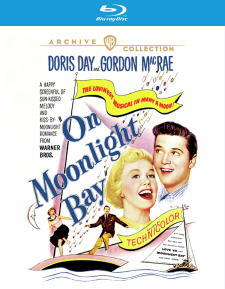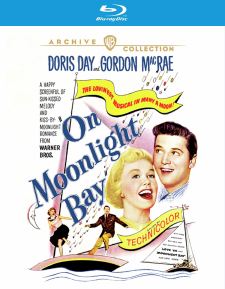On Moonlight Bay (Blu-ray Review)

Director
Roy Del RuthRelease Date(s)
1951 (February 23, 2021)Studio(s)
Warner Bros (Warner Archive Collection)- Film/Program Grade: C+
- Video Grade: A
- Audio Grade: A
- Extras Grade: C+
Review
Doris Day made her feature film debut in Romance on the High Seas in 1948 and soon became a top star at Warner Bros. Attractive, with a crystal clear voice, and the ability to dance, she appeared in a number of musicals for the studio and proved popular with moviegoers. On Moonlight Bay, her ninth feature film, relies on her fresh-scrubbed charm, nostalgia for the olden days, and songs popular in the early twentieth century.
Adapted from the Penrod stories by Booth Tarkington, the film is set in a small Indiana town in 1917. Day plays tomboyish Marjie, daughter of banker George Winfield (Leon Ames) and his wife, Alice (Rosemary De Camp). Marjie’s eleven-year-old brother, Wesley (Billy Gray, TV’s Father Knows Best) has a knack for getting himself and others into mischief.
Marjie “meets cute” with across-the-street neighbor William Sherman (Gordon MacRae) when a gun accidentally discharges, crashing a barn door on top of him. She’s a tomboy with a powerful pitching arm, he’s a senior at Indiana University, but eventually this superficially mismatched pair start dating. With her mother’s help, Marjie transforms into a lovely young woman, leaving her baseball uniform and cap by the wayside.
William expounds to Marjie his many opinions about the world’s troubles and how people behave frivolously in difficult times. He even regards Mr. Winfield as part of the problem, declaring that bankers are instrumental in causing the world’s evils. Obviously, this doesn’t endear him to Winfield, who forbids them to see each other.
This is the extent of the conflict in this folksy, wholesome story. The film relies on a catalogue of period songs to bolster the thin plot, and the antics of Wesley to infuse some humor. Day’s character is the typical girl next door, with the exception of a tomboyish bent that disappears early on when romance rears its head. Day and MacRae make a pleasant on-screen couple. Though MacRae is a lightweight in terms of acting, his singing is lovely and his duets with Day are enjoyable, if somewhat stiff.
The film benefits from supporting performances by Ellen Corby as a prudish school teacher and Mary Wickes as the Winfields’ housekeeper, always ready with a well-placed wisecrack. Jack Smith appears as Hubert Wakely, a suitor for Marjie whose straitlaced manner and self-importance are played for laughs. As competition for William, he’s hardly a threat.
Billy Gray is prominently featured, with considerable screen time. His scenes are some of the liveliest in the picture and balance the romantic narrative. A scene of Wesley watching a silent film, his mouth stuffed with candy, features a movie-within-the-movie of a broad romantic melodrama that offers some of the best laughs in the film. Gray, who would befriend an alien from another world the same year in The Day the Earth Stood Still, turns in a natural performance and delivers a much more interesting character than either of the leads.
Director Roy Del Ruth incorporates a running gag of housekeeper Mary Wickes, carrying a tray full of dishes and having it repeatedly knocked out of her hands by a swinging door. It’s mildly funny the first time but doesn’t justify multiple reprises. The script, lead performances, and humor contribute to a lackluster musical.
Among the songs, which were already antiquated by the time film was made, are Cuddle Up a Little Closer, I’m Forever Blowing Bubbles, Till We Meet Again, Ain’t We Got Fun, Every Little Movement (Has a Meaning All Its Own), It’s a Long Way to Tipperary, Pack Up Your Troubles in Your Old Kit Bag, and Tell Me. Only one original song was added, the uninspired Love Ya, sung by Doris Day and Jack Smith. The musical numbers are staged with little originality or cinematic pizzazz by Leroy Prinz.
On Moonlight Bay features many elements of Meet Me in St. Louis, made seven years earlier. Both are set around the same period, both feature Leon Ames as the family patriarch, both take place in the Midwest, both have a sharp-tongued housekeeper, and both have key scenes set during the Christmas season. But the warmth of Meet Me in St, Louis and the emotional portrayal by Judy Garland make it an unquestionable classic. On Moonlight Bay is simply a second-tier musical coasting on the talents of Doris Day.
Director of photography Ernst Haller shot On Moonlight Bay with spherical lenses on 35 mm film which was finished photochemically, and presented in the aspect ratio of 1.37:1. The Blu-ray release by the Warner Archive Collection is sourced from a 4K scan of the original Technicolor negative, providing a clean presentation, free of imperfections. Film grain has been retained. The color palette is bright with primary colors, especially reds (Day’s hair ribbon, MacRae’s blazer) and yellows (Day’s frilly dress) prominent. Day’s peaches-and-cream freshly scrubbed face is photographed beautifully, in keeping with the studio’s attempt to have their star looking her best. A scene in which MacRae and Day are in the dark and light a match for illumination is helped considerably by an obvious spotlight on them.
The soundtrack is presented in English 2.0 mono DTS-HD Master Audio. English SDH subtitles are an available option. Dialogue is clear and distinct throughout. The musical numbers possess great clarity, balanced with ambient background sounds to create the illusion that they’re being sung in the real world, not on an antiseptic sound stage. The sound effects department got carried away by a single shot from a revolver that sounds like a cannon blast and, according to the visuals, has enough power to blow a door off a barn.
Bonus materials include the following:
- Let’s Sing a Song About the Moonlight (9:24)
- A Hound in Trouble (7:09)
- Theatrical Trailer (2:32)
Let’s Sing a Song About the Moonlight – This 1948 musical short features brief vignettes of actors and the Melody Makers performing popular songs with “moonlight” in their lyrics, and a sing-along follows each number. The songs are By the Light of the Silvery Moon, On Moonlight Bay, In the Evening by the Moonlight, and Shine on Harvest Moon. Ann Sheridan and Dennis Morgan are featured in a film clip.
A Hound for Trouble – This 1951 cartoon, directed by Chuck Jones, features Mel Blanc as the voice of Charlie the dog. After being kicked off a boat, Charlie attempts to take over a restaurant in Italy while its owner is on a short break. Charlie’s behavior drives away a customer, and the owner gets upset. He eventually seems to accept Charlie as a partner but actually uses the dog’s newfound trust to trick him.
On Moonlight Bay mixes romance, humor, and music, yet never soars. Seen today, it feels like a B picture rather than a major release. However, the film and Day’s character were popular enough for a sequel, By the Light of the Silvery Moon, which was made two years later.
- Dennis Seuling

